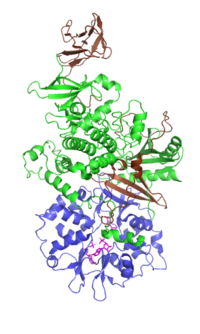
Follistatin-controlled activin-HNF4α-coagulation factor axis in liver progenitor cells determines outcome of acute liver failure.
Sign Up to like & getrecommendations! Published in 2021 at "Hepatology"
DOI: 10.1002/hep.32119
Abstract: BACKGROUND & AIMS In patients with acute liver failure (ALF) who suffer from massive hepatocyte loss, liver progenitor cells (LPC) take over key hepatocyte functions, which ultimately determines survival. This study investigated how the expression… read more here.
Keywords: coagulation; liver failure; follistatin; hnf4 ... See more keywords

Nuclear receptor HNF4α performs a tumor suppressor function in prostate cancer via its induction of p21-driven cellular senescence
Sign Up to like & getrecommendations! Published in 2019 at "Oncogene"
DOI: 10.1038/s41388-019-1080-3
Abstract: Hepatocyte nuclear factor 4α (HNF4α, NR2A1) is a highly conserved member of the nuclear receptor superfamily. Recent advances reveal that it is a key transcriptional regulator of genes, broadly involved in xenobiotic and drug metabolism… read more here.
Keywords: cancer; cellular senescence; prostate cancer; hnf4 ... See more keywords

TGR5-HNF4α axis contributes to bile acid-induced gastric intestinal metaplasia markers expression
Sign Up to like & getrecommendations! Published in 2020 at "Cell Death Discovery"
DOI: 10.1038/s41420-020-0290-3
Abstract: Intestinal metaplasia (IM) increases the risk of gastric cancer. Our previous results indicated that bile acids (BAs) reflux promotes gastric IM development through kruppel-like factor 4 (KLF4) and caudal-type homeobox 2 (CDX2) activation. However, the… read more here.
Keywords: intestinal metaplasia; hnf4 axis; hnf4; acid ... See more keywords

A reinforcing HNF4-SMAD4 feed-forward module stabilizes enterocyte identity
Sign Up to like & getrecommendations! Published in 2019 at "Nature genetics"
DOI: 10.1038/s41588-019-0384-0
Abstract: BMP/SMAD signaling is a crucial regulator of intestinal differentiation1–4. However, the molecular underpinnings of the BMP pathway in this context are unknown. Here, we characterize the mechanism by which BMP/SMAD signaling drives enterocyte differentiation. We… read more here.
Keywords: hnf4 smad4; module; hnf4; stabilizes enterocyte ... See more keywords

HNF4-alpha in hepatocyte health and disease.
Sign Up to like & getrecommendations! Published in 2023 at "Seminars in liver disease"
DOI: 10.1055/a-2097-0660
Abstract: Hepatocyte Nuclear Factor 4 alpha (HNF4α) is a highly conserved member of the nuclear receptor superfamily expressed at high levels in the liver, kidney, pancreas, and gut. In the liver, HNF4α is exclusively expressed in… read more here.
Keywords: hnf4 alpha; alpha hepatocyte; liver; disease ... See more keywords

HNF4α is possibly the missing link between epithelial–mesenchymal transition and Warburg effect during hepatocarcinogenesis
Sign Up to like & getrecommendations! Published in 2022 at "Cancer Science"
DOI: 10.1111/cas.15686
Abstract: Hepatocellular carcinoma (HCC) is a heterogeneous, late‐diagnosed, and highly recurrent malignancy that often affects the whole body's metabolism. Finding certain theranostic molecules that can address current concerns simultaneously is one of the priorities in HCC… read more here.
Keywords: warburg effect; hnf4; epithelial mesenchymal; mesenchymal transition ... See more keywords

Conjugated Linoleic Acid Treatment Attenuates Cancerous features in Hepatocellular Carcinoma Cells
Sign Up to like & getrecommendations! Published in 2022 at "Stem Cells International"
DOI: 10.1155/2022/1850305
Abstract: Background A growing number of hepatocellular carcinoma (HCC), and recurrence frequency recently have drawn researchers' attention to alternative approaches. The concept of differentiation therapies (DT) relies on inducing differentiation in HCC cells in order to… read more here.
Keywords: hepatocellular carcinoma; conjugated linoleic; hcc cells; linoleic acid ... See more keywords

HNF4α-deficient Fatty Liver Provides a Permissive Environment for Sex-independent Hepatocellular Carcinoma.
Sign Up to like & getrecommendations! Published in 2019 at "Cancer research"
DOI: 10.1158/0008-5472.can-19-1277
Abstract: The incidence of hepatocellular carcinoma (HCC) is on the rise worldwide. Although the incidence of HCC in males is considerably higher than in females, the projected rates of HCC incidence are increasing for both sexes.… read more here.
Keywords: incidence; hepatocellular carcinoma; hcc; fatty liver ... See more keywords

P1 promoter-driven HNF4α isoforms are specifically repressed by β-catenin signaling in colorectal cancer cells
Sign Up to like & getrecommendations! Published in 2018 at "Journal of Cell Science"
DOI: 10.1242/jcs.214734
Abstract: ABSTRACT HNF4α is a key nuclear receptor for regulating gene expression in the gut. Although both P1 and P2 isoform classes of HNF4α are expressed in colonic epithelium, specific inhibition of P1 isoforms is commonly… read more here.
Keywords: isoforms specifically; catenin; colorectal cancer; hnf4 ... See more keywords

A potent HNF4α agonist reveals that HNF4α controls genes important in inflammatory bowel disease and Paneth cells
Sign Up to like & getrecommendations! Published in 2022 at "PLoS ONE"
DOI: 10.1371/journal.pone.0266066
Abstract: HNF4α has been implicated in IBD through a number of genome-wide association studies. Recently, we developed potent HNF4α agonists, including N-trans caffeoyltyramine (NCT). NCT was identified by structural similarity to previously the previously identified but… read more here.
Keywords: paneth; high fat; paneth cells; potent hnf4 ... See more keywords

Influence of HNF4α and HNF4α-AS1 gene variants on the risk of anti-tuberculosis drugs-induced hepatotoxicity.
Sign Up to like & getrecommendations! Published in 2021 at "Annals of palliative medicine"
DOI: 10.21037/apm-21-2924
Abstract: BACKGROUND The most serious and common complication of the medication recommended by World Health Organization (WHO) for tuberculosis (TB) is anti-tuberculosis drugs-induced hepatotoxicity (ATDH). Pregnane X receptor (PXR) is a key factor of ATDH, while… read more here.
Keywords: hnf4 hnf4; anti tuberculosis; hnf4; hnf4 as1 ... See more keywords